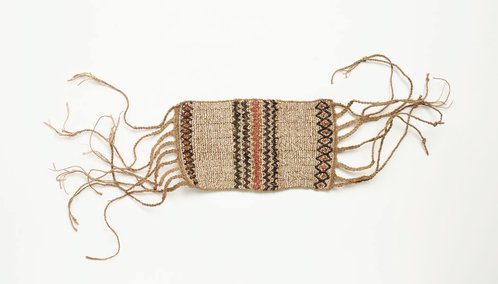

-
Details
- Place where the work was made
-
Malaita
→
Malaita Province
→
Solomon Islands
- Cultural origin
- Langalanga people
- Date
- late 19th century-early 20th century
- Media categories
- Jewellery , Ceremonial object
- Materials used
- nine lengths of shell beads consisting of ridged white cockle shell (Anadara granosa) disks, red-lipped oyster shell (Chana pacifica) disks, black mussel shell (Atrina vexillum) disks, black 'fulu' seeds, six turtoise shell spacers, plant fibre string
- Dimensions
- 70.0 cm length; 5.0 cm width
- Credit
- Purchased under the terms of the Florence Turner Blake Bequest 2015
- Location
- Not on display
- Accession number
- 260.2015
- Copyright
- Artist information
-
Langalanga people
Works in the collection
- Share
-
-
About
Malaita is one of a group of islands that forms the Solomon chain, which lies southeast of the island of New Guinea. Large reefs and lagoons are found on both sides of Malaita. The Langalanga, who live mainly on artificial or semi-artificial islets in a lagoon on the west coast, produce various kinds of shell 'money', which is distributed and exchanged throughout the island.
Four species of marine shells are sourced to produce the red, white and black beads that are incorporated into shell valuables. Red is the most important and powerful colour and is associated with adulthood. Red shells are incorporated in the most valuable objects still used today as part of gift exchanges in marriage ceremonies. White is often used in children's ornaments, and the word 'kwao' means shining, or clear, and denotes innocence. Black is largely used to delineate designs or to flank red areas of shell disc work. According to researcher Kay Ross, the word for black - 'bobora' - 'has the connotation of earthly, unclear and dark' (1). Black vegetable seeds called 'fulu' from the 'sisis' tree are also used to produce black beads.
According to Charles Woodford, who published the earliest study of Malaitan shell money in 1908, women produced the small round shell discs, however, only men polished the finished beads, known as 'bata', which are strung onto lengths of bush fibre string called 'lili' (2).
This belt comprises four sections of nine lengths of white shell discs with a small central band of nine lengths of red and white shell discs and black 'fulu' seeds, divided in sections with thin strips of tortoise shell. One section of white shell discs is divided in two and each length twisted to form two rope-like bands.
(1) Kay Ross, 'Shell ornaments of Malaita', Expedition, Winter 1981, pp 20-26
(2) C M Woodford, 'Notes on the manufacture of the Malaita shell bead money of the Solomon Group', Man, vol 8, 1908, pp 81-84


